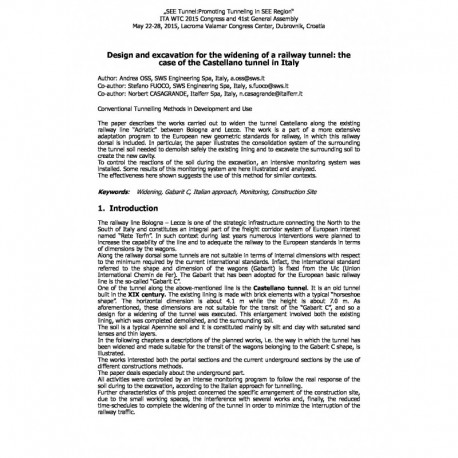Cart
0
0
No document
0,00 €
Total
Document successfully added to your shopping cart
Quantity
Total
There are 0 items in your cart.
There is 1 item in your cart.
Total documents
Total shipping
To be determined
Total
Search & filter
Search for a publication
Search & filter
Design and excavation for the widening of a railway tunnel: the case of the Castellano tunnel in Italy
wtc2015_full_oss
S. Fuoco / A. Oss / N. Casagrande
The railway line Bologna – Lecce is one of the strategic infrastructure connecting the North to the South of Italy and constitutes an integral part of the freight corridor system of European interest named “Rete Terfn”. In such context during last years numerous interventions were planned to increase the capability of the line and to adequate the railway to the European standards in terms of dimensions by the wagons. Along the railway dorsal some tunnels are not suitable in terms of internal dimensions with respect to the minimum required by the current international standards. Infact, the international standard referred to the shape and dimension of the wagons (Gabarit) is fixed from the Uic (Union International Chemin de Fer). The Gabarit that has been adopted for the European basic railway line is the so-called “Gabarit C”. One of the tunnel along the above-mentioned line is the . It is an old tunnel built in the The existing lining is made with brick elements with a typical “horseshoe shape”. The horizontal dimension is about 4.1 m while the height is about 7.0 m. As aforementioned, these dimensions are not suitable for the transit of the “Gabarit C”, and so a design for a widening of the tunnel was executed. This enlargement involved both the existing lining, which was completed demolished, and the surrounding soil. The soil is a typical Apennine soil and it is constituted mainly by silt and clay with saturated sand lenses and thin layers. In the following chapters a descriptions of the planned works, i.e. the way in which the tunnel has been widened and made suitable for the transit of the wagons belonging to the Gabarit C shape, is illustrated. The works interested both the portal sections and the current underground sections by the use of different constructions methods. The paper deals especially about the underground part. All activities were controlled by an intense monitoring program to follow the real response of the soil during to the excavation, according to the Italian approach for tunnelling. Further characteristics of this project concerned the specific arrangement of the construction site, due to the small working spaces, the interference with several works and, finally, the reduced time-schedules to complete the widening of the tunnel in order to minimize the interruption of the railway traffic.




